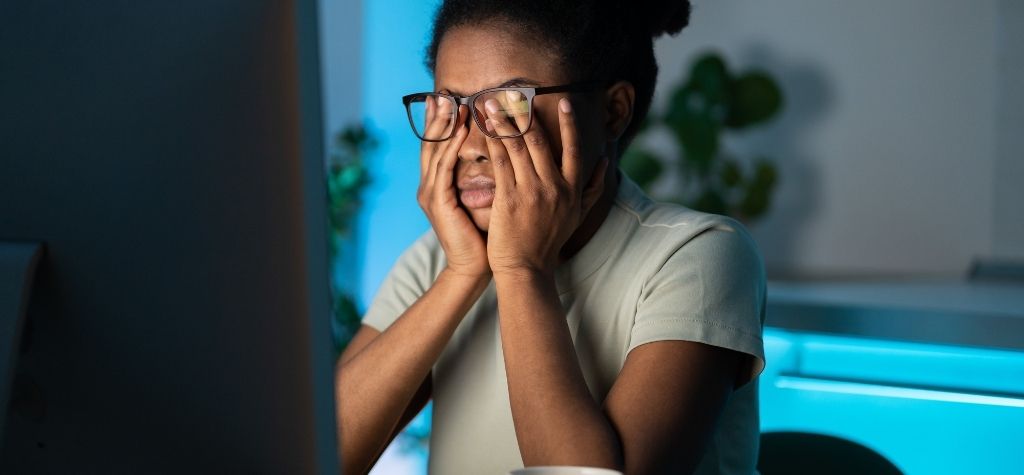Digital eye strain, also known as computer vision syndrome, is a condition that arises from prolonged use of digital devices such as computers, smartphones, and tablets. As more people spend hours daily in front of screens, digital eye strain has become a widespread issue, affecting millions. This article explores the causes, symptoms, and prevention techniques for digital eye strain, providing a comprehensive guide to protecting your eye health in the digital age.
How I Finally Found Relief from Eye Strain
I used to hit 3pm with gritty, burning eyes—and a headache that wrecked my focus.
Then a coworker sent me a link I almost ignored. A few weeks later, the blurriness eased, the tension lifted, and my screen stopped “fighting” me.
Not a miracle—just a routine that finally made sense for heavy screen time.
Introduction to Digital Eye Strain

Digital eye strain is the discomfort or vision problems that occur due to extended periods of screen time. It is particularly common among those who work on computers, play video games, or spend significant time on their phones. As screen use increases, understanding how to prevent and manage digital eye strain becomes increasingly important.
Definition of Digital Eye Strain
Digital eye strain refers to a range of eye and vision-related problems caused by prolonged screen use. Symptoms often include discomfort, dryness, headaches, and blurred vision.
Overview of Its Growing Prevalence in the Digital Age
As we rely more on digital devices for work, education, and entertainment, cases of digital eye strain have surged. Remote work, online learning, and social media have made screen time an unavoidable part of modern life.
Causes of Digital Eye Strain
Several factors contribute to digital eye strain, many of which relate to how we interact with screens.
Excessive Screen Time
Spending long hours staring at screens without breaks can strain the eye muscles and lead to discomfort.
Poor Ergonomics and Posture
Improper screen positioning or bad posture can force your eyes to work harder, contributing to strain and even causing neck and shoulder pain.
Improper Lighting (Glare and Screen Brightness)
Excessive glare from screens or ambient light, as well as improper screen brightness, can make it difficult for your eyes to focus comfortably.
Uncorrected Vision Problems
If you have an undiagnosed or untreated vision issue (such as nearsightedness, farsightedness, or astigmatism), using digital devices may exacerbate eye strain.
Symptoms of Digital Eye Strain

Recognizing the symptoms of digital eye strain is key to addressing the problem early on.
Eye Discomfort and Irritation
This includes dryness, itching, or a burning sensation in the eyes after using screens for extended periods.
Blurred Vision
Difficulty focusing or experiencing blurred vision is a common symptom, particularly after staring at screens for hours.
Headaches and Neck/Shoulder Pain
Tension headaches and neck or shoulder pain can accompany eye strain, especially when poor ergonomics are involved.
Difficulty Focusing
Your eyes may struggle to shift focus between a screen and other objects, particularly after extended screen use.
The Science Behind Digital Eye Strain
Understanding the science behind digital eye strain can help you take steps to prevent it.
How Digital Screens Affect Your Eyes
Digital screens emit light, and the continuous focusing required to read or interact with them can tire out the eye muscles.
The Role of Blue Light and Screen Flicker
Blue light emitted by digital screens can disrupt your circadian rhythm and contribute to eye strain. Screen flicker, although subtle, can also add to eye discomfort.
Blink Rate and Moisture Loss
We tend to blink less frequently when using screens, leading to dry eyes and discomfort. Blinking is essential for keeping the eyes moist and healthy.
How Digital Eye Strain Affects Long-Term Eye Health
Long-term exposure to screens without addressing eye strain can have cumulative effects on your vision.
Potential for Worsening Vision (Myopia, Astigmatism)
Prolonged screen use can contribute to the progression of nearsightedness (myopia) or other refractive errors like astigmatism.
Cumulative Effects on Eye Health
Over time, constant digital eye strain can lead to chronic discomfort, eye fatigue, and more severe vision problems.
Risk Factors for Developing Digital Eye Strain

Certain factors make some individuals more susceptible to digital eye strain than others.
Age and Eye Health Status
Older individuals may experience more strain due to age-related changes in vision. Those with existing vision issues are also more prone to strain.
Type of Work or Screen Activity
Jobs that require extended screen use, such as IT, design, or gaming, increase the risk of developing digital eye strain.
Amount of Daily Screen Time
The more time spent in front of screens without breaks, the higher the likelihood of developing digital eye strain.
Preventing Digital Eye Strain: Simple Tips
Fortunately, there are simple strategies to prevent digital eye strain and keep your eyes healthy.
The 20-20-20 Rule (And How It Works)
To reduce eye strain, follow the 20-20-20 rule: Every 20 minutes, look at something 20 feet away for 20 seconds. This helps relax the eye muscles.
Adjusting Screen Settings and Lighting
Lower the brightness of your screen and ensure it matches the lighting in your environment. Reducing glare with an anti-glare screen or adjusting room lighting can also help.
Proper Ergonomics for Screen Use
Position your screen at eye level and maintain good posture. Ensure that you’re seated comfortably with your feet flat on the floor to prevent strain on your neck and shoulders.
Blue Light and Digital Eye Strain: Is There a Connection?

Blue light is often blamed for digital eye strain, but how much of an impact does it really have?
What Role Does Blue Light Play in Eye Strain?
Blue light from digital screens may contribute to digital eye strain, but its primary effect is disrupting sleep patterns when used at night.
Blue Light Filters and Screen Settings
Many devices now offer “night mode” or blue light filtering options, which reduce blue light emission and may help reduce strain.
Blue Light Blocking Glasses: Are They Effective?
Blue light blocking glasses are designed to filter out harmful blue light. Some users report relief from eye strain, but the effectiveness of these glasses varies.
Creating a Digital Eye-Friendly Workspace
A well-organized workspace can go a long way in reducing eye strain.
Ideal Screen Placement and Posture
Your screen should be about 20-24 inches from your eyes and positioned at eye level to minimize strain.
Reducing Glare and Adjusting Lighting
Position your screen to avoid glare from windows or overhead lighting. Soft, indirect lighting is best for reducing screen glare.
Reducing Eye Strain During Extended Screen Use
When you can’t avoid prolonged screen use, there are ways to minimize the impact on your eyes.
Taking Regular Breaks
Taking breaks every 20-30 minutes to rest your eyes can significantly reduce strain.
Eye Exercises and Stretches
Performing simple eye exercises, such as rolling your eyes or focusing on distant objects, can help relax your eye muscles.
Using Eye Drops for Moisture
Artificial tears or eye drops can help keep your eyes moist, particularly if you experience dryness due to reduced blinking during screen use.
The Role of Computer Glasses in Reducing Eye Strain

Computer glasses are specially designed to reduce the strain associated with digital screens.
What Are Computer Glasses?
These are glasses designed to reduce glare and optimize focus for close-up work, such as viewing a computer screen.
How They Differ from Regular Prescription Lenses
Computer glasses are designed with intermediate focusing power, specifically for screen distances, which may not be the same as regular reading or prescription glasses.
When to Consider Computer Glasses
If you frequently experience eye strain despite taking other precautions, computer glasses may provide relief, especially for those who spend most of the day on screens.
Digital Eye Strain in Children and Teens
Children and teens are also at risk for digital eye strain, as screen time becomes a bigger part of education and entertainment.
Increased Screen Use Among Younger Generations
With the rise of online learning and gaming, children are exposed to screens for longer periods, increasing the risk of digital eye strain.
How Digital Eye Strain Affects Developing Eyes
Prolonged screen use can cause eye discomfort in children, and since their eyes are still developing, they may be more susceptible to the effects of blue light and eye strain.
Tips for Reducing Eye Strain in Children
Encourage children to take regular breaks, use devices in well-lit environments, and reduce screen time before bed to protect their eye health.
Long-Term Eye Care in the Digital Age
Prioritizing regular eye care is essential for maintaining eye health, especially with increasing screen use.
Regular Eye Check-Ups and Vision Assessments
Routine eye exams can help detect and address vision problems early, preventing them from worsening over time.
Managing Eye Health as Screen Time Increases
Staying proactive about eye health through regular check-ups, protective eyewear, and good screen habits is crucial in the digital era.
Workplace Strategies for Reducing Digital Eye Strain
Employers can play a role in reducing digital eye strain by creating eye-friendly work environments.
Encouraging Regular Breaks
Workplace policies that encourage regular screen breaks can help prevent eye strain among employees.
Ergonomic Workstations
Setting up ergonomic workstations with proper lighting, screen placement, and comfortable seating can help reduce digital eye strain.
Educating Employees About Eye Health
Providing educational materials on eye health and digital eye strain prevention can promote healthier screen habits in the workplace.
The Future of Digital Eye Strain Prevention

As technology evolves, so do the solutions for preventing digital eye strain.
Emerging Technologies to Reduce Eye Strain
Advances in screen technology, such as e-ink displays and improved blue light filtering, aim to reduce the impact of screens on eye health.
Predicting Trends in Screen Design and Eye Care
Future screens may be designed with eye health in mind, incorporating features like adjustable lighting and adaptive refresh rates to minimize strain.
Frequently Asked Questions (FAQs)
What causes digital eye strain?
Digital eye strain is caused by prolonged screen use, poor ergonomics, and improper lighting.
How can I avoid eye strain during screen use?
Take regular breaks, adjust your screen brightness, and ensure proper posture to minimize eye strain.
Are blue light glasses helpful for digital eye strain?
Blue light glasses may help reduce strain for some users, but other factors like screen glare and posture play a bigger role.
How often should I take breaks to reduce eye strain?
Follow the 20-20-20 rule: Every 20 minutes, look at something 20 feet away for 20 seconds to reduce strain.
Can digital eye strain lead to permanent vision problems?
While digital eye strain is usually temporary, chronic strain without proper care can contribute to long-term issues like myopia.
What screen settings can reduce eye strain?
Adjusting brightness, enabling blue light filters, and reducing screen glare can all help minimize strain.
Conclusion
Digital eye strain is a common issue in today’s screen-dominated world, but it’s preventable with the right habits and tools. By following practical tips like taking breaks, adjusting your screen settings, and using proper ergonomics, you can avoid eye strain and maintain your eye health in the digital age.

